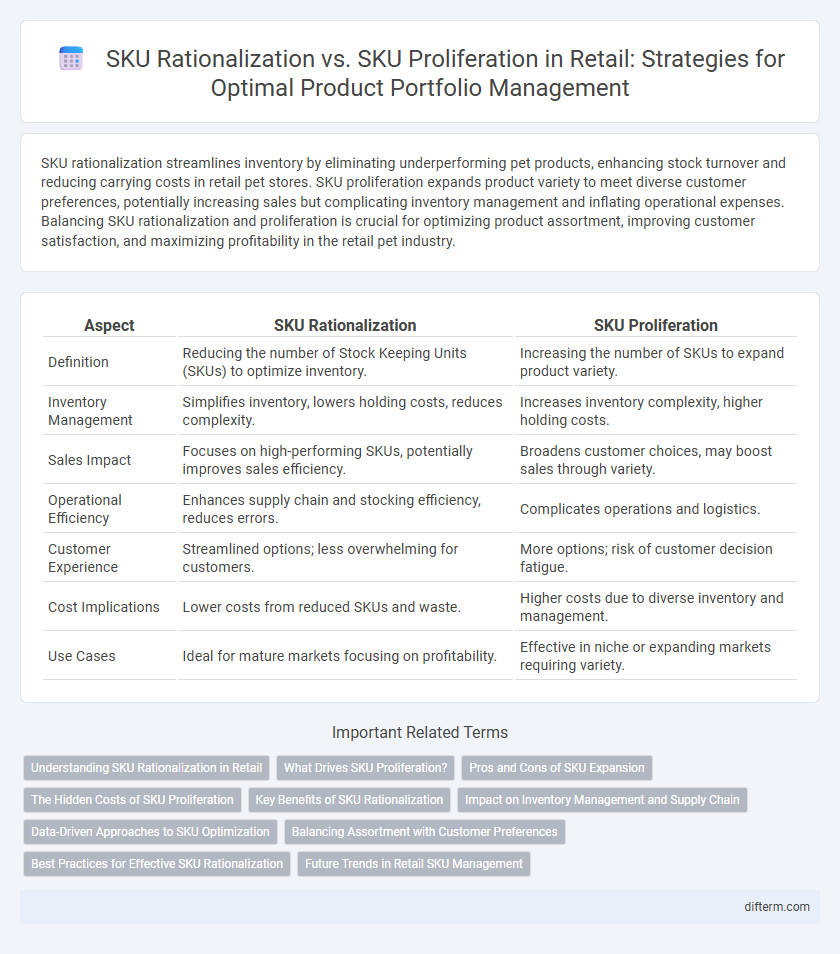SKU rationalization streamlines inventory by eliminating underperforming pet products, enhancing stock turnover and reducing carrying costs in retail pet stores. SKU proliferation expands product variety to meet diverse customer preferences, potentially increasing sales but complicating inventory management and inflating operational expenses. Balancing SKU rationalization and proliferation is crucial for optimizing product assortment, improving customer satisfaction, and maximizing profitability in the retail pet industry.
Table of Comparison
| Aspect | SKU Rationalization | SKU Proliferation |
|---|---|---|
| Definition | Reducing the number of Stock Keeping Units (SKUs) to optimize inventory. | Increasing the number of SKUs to expand product variety. |
| Inventory Management | Simplifies inventory, lowers holding costs, reduces complexity. | Increases inventory complexity, higher holding costs. |
| Sales Impact | Focuses on high-performing SKUs, potentially improves sales efficiency. | Broadens customer choices, may boost sales through variety. |
| Operational Efficiency | Enhances supply chain and stocking efficiency, reduces errors. | Complicates operations and logistics. |
| Customer Experience | Streamlined options; less overwhelming for customers. | More options; risk of customer decision fatigue. |
| Cost Implications | Lower costs from reduced SKUs and waste. | Higher costs due to diverse inventory and management. |
| Use Cases | Ideal for mature markets focusing on profitability. | Effective in niche or expanding markets requiring variety. |
Understanding SKU Rationalization in Retail
SKU rationalization in retail involves analyzing product performance data to identify underperforming or redundant stock keeping units, enabling retailers to streamline inventory and improve profitability. This process uses metrics such as sales velocity, margin contribution, and inventory turnover rates to prioritize high-performing SKUs and eliminate those that impede operational efficiency. Effective SKU rationalization reduces carrying costs, minimizes stockouts, and enhances shelf space optimization, ultimately driving smarter assortment planning and inventory management.
What Drives SKU Proliferation?
SKU proliferation in retail is primarily driven by consumer demand for variety and the need to cater to diverse preferences across demographics and regions. Competitive pressure compels retailers to expand product assortments to capture market share and address niche segments, while promotional strategies often incentivize manufacturers to introduce new SKUs. Supply chain and technological advancements also enable retailers to manage larger inventories, facilitating the growth in SKU counts.
Pros and Cons of SKU Expansion
SKU proliferation in retail can lead to increased customer choice and higher sales potential by catering to diverse consumer preferences and market niches. However, it often results in higher inventory costs, complex supply chain management, and increased risk of stockouts or overstock situations. Balancing SKU expansion requires careful analysis of sales data and profitability to avoid inefficiencies and ensure optimal product assortment.
The Hidden Costs of SKU Proliferation
SKU proliferation in retail often leads to increased inventory holding costs, reduced shelf space efficiency, and complex supply chain management. These hidden costs erode profit margins and complicate demand forecasting, leading to excess stock or stockouts. Streamlining product assortments through SKU rationalization enables retailers to optimize operational costs and improve overall profitability.
Key Benefits of SKU Rationalization
SKU rationalization enhances inventory management by eliminating underperforming products, which reduces holding costs and improves supply chain efficiency. It streamlines product assortments, making it easier for retailers to focus on high-margin and high-demand SKUs, boosting overall profitability. This process also simplifies forecasting and demand planning, leading to lower stockouts and increased customer satisfaction.
Impact on Inventory Management and Supply Chain
SKU rationalization streamlines inventory management by reducing excess stock and minimizing carrying costs, leading to improved demand forecasting and efficient warehouse utilization. In contrast, SKU proliferation complicates supply chain operations through increased complexity in procurement, higher risk of stockouts, and greater logistical challenges in distribution. Effective balance between SKU variety and operational efficiency is critical for optimizing inventory turnover and supply chain responsiveness in retail.
Data-Driven Approaches to SKU Optimization
Data-driven SKU optimization leverages advanced analytics and machine learning to evaluate product performance, customer preferences, and inventory turnover, enabling retailers to balance SKU rationalization and proliferation effectively. By integrating point-of-sale data, market trends, and profitability metrics, retailers can identify redundant or underperforming SKUs while pinpointing high-demand variations that drive sales growth. This systematic approach enhances inventory efficiency, reduces carrying costs, and maximizes shelf productivity in competitive retail environments.
Balancing Assortment with Customer Preferences
SKU Rationalization streamlines inventory by eliminating low-performing products to reduce costs and improve supply chain efficiency. SKU Proliferation expands product variety to meet diverse customer preferences and capture niche markets, enhancing customer satisfaction. Balancing assortment involves analyzing sales data and customer behavior to optimize SKU count, ensuring adequate choice without overwhelming inventory complexity.
Best Practices for Effective SKU Rationalization
Effective SKU rationalization in retail involves analyzing sales data, profit margins, and inventory turnover to identify underperforming products for elimination. Implementing category management techniques and using predictive analytics helps optimize SKU assortments, reducing complexity and improving supply chain efficiency. Engaging cross-functional teams ensures alignment on SKU decisions, driving better customer satisfaction and increased profitability.
Future Trends in Retail SKU Management
Future trends in retail SKU management emphasize data-driven SKU rationalization to optimize inventory and reduce carrying costs while addressing consumer demand fragmentation. Advanced analytics and AI enable retailers to predict sales patterns, enhancing SKU assortment precision and minimizing overstock issues associated with SKU proliferation. Integration of omnichannel strategies further drives dynamic SKU categorization, aligning product offerings with evolving customer behavior and boosting overall supply chain efficiency.
SKU Rationalization vs SKU Proliferation Infographic

 difterm.com
difterm.com